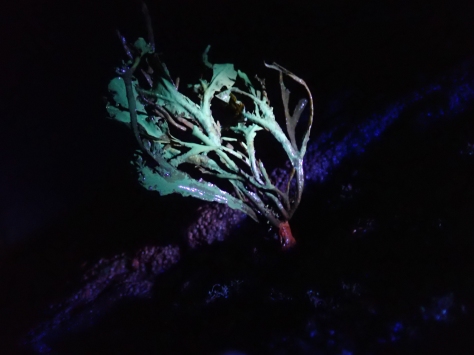Ever since we discovered gem anemones in the pools at Plaidy last week, Junior has been planning a night-time trip to see them fluorescing under ultraviolet light. Lots of anemones glow in UV due to special proteins they contain that absorb the ultraviolet light before re-transmitting it at a longer, visible wavelength.
Snakelocks anemones are well-known in rockpooling circles for glowing a vivid, eerie green in UV and we have seen those many times, but we’re intrigued to see if gem anemones are as spectacular by night as they are by day.

Other-Half joins our after-dark ramble. We wrap up and walk through the deserted lanes. In the light of the rising full moon, there’s no need for torches. The stars have been out for a while already and the Eddystone lighthouse is flashing away at the horizon.
It took us quite a while to spot the gem anemones by daylight. Despite their pretty colours, they are tiny and well camouflaged among the pink encrusting seaweed that lines the pools.
We cross the sand and the heap of seaweed that the tide has brought in to the far rocks and take our UV torch out. Junior scans it over the pool and within seconds we’ve found them. They seem to light up in patterns of green and orange.

We kneel down and look closely at the starburst of orange that radiates out from the turquoise and pink mouth at the anemone’s centre. The green fringes to the tentacles that are sometimes visible by day are unmissable now.

Junior is keen to look at the sponges and seaweeds to see what they do under UV and leads me on a precarious climb towards an overhang he knows. The rocks here glow insanely orange and though it’s hard to tell what is causing this effect in the dark, it feels like either a dense red seaweed or a sponge.

As we scramble over the rocks, we find more fluorescing plants and animals. A brown seaweed glows green, possibly due to micro-algae that is growing on its fronds.

Grey topshells are easy to spot because the tip of their shell glows pink.

We are intrigued by thin bright-blue streaks among the seaweed. It takes a while for us to realise that these are man-made threads. They feel coarse and may well be fibres from a fishing net. Many seaweeds on the shore are so tangled in them that it is almost impossible to clear the plastic fibres without damaging the seaweed.

In a shallow, rocky pool lined with sediment more anemones are glowing. These look nothing like the gem, snakelocks or daisy anemones I’ve seen so far.

I turn my normal torch on them to see what species they are and I can’t see them at all. By switching back between UV and normal light I manage to pinpoint them. They are at least as small as the gem anemone, but are flecked with a marble of brown, white and orange that blends perfectly into the sand and rock around them.
Under the camera I can make out dark ‘B’ shaped markings at the base of the tentacles and realise this is Sagartia troglodytes. I don’t remember seeing this anemone before, probably because it would be almost impossible to spot in daylight.

I touch one of the anemones gently with a finger and it retracts in a puff of sediment, disappearing without trace.
I take photos while Junior and Other Half climb onto a high rock to watch the stars. On nights like this it is hard to tell whether the sea or the sky is shining more brightly. With a last sweep of the torch over the glowing anemones we turn away and head home for hot drinks.





Absolutely wonderful.
LikeLiked by 1 person
Thanks Scooj. We love our UV torch!
LikeLiked by 1 person
I’m speechless! The colours, the contrast, the brightness: everything looks incredibly beautiful. Great photos!
LikeLiked by 1 person
Thank you for your lovely comments. It’s well worth a night-time expedition to the rock pools. There are some guided ones with Cornwall Wildlife Trust this summer for anyone who wants to give it a go. 🙂
LikeLike
Looks like we are on to the same thing!
LikeLiked by 1 person
Wonderful photos Heather thank you
LikeLiked by 1 person
Thanks Frances 🙂
LikeLike
What an amazing experience – and fantastic photographs.
LikeLiked by 1 person
Thanks Trisha. It was a perfect night for it and exciting to make some new discoveries on a familiar beach. 🙂
LikeLike
Amazing, what UV torch do you have or would recommend?
LikeLike
Thanks Anna. I’m not sure what make/model my torch is but it’s a basic hand-held UV torch – there are quite a few options online. Mine’s not a specialist diving-type torch so I have to be careful not to drop it in the water. So far so good! 😀
LikeLike